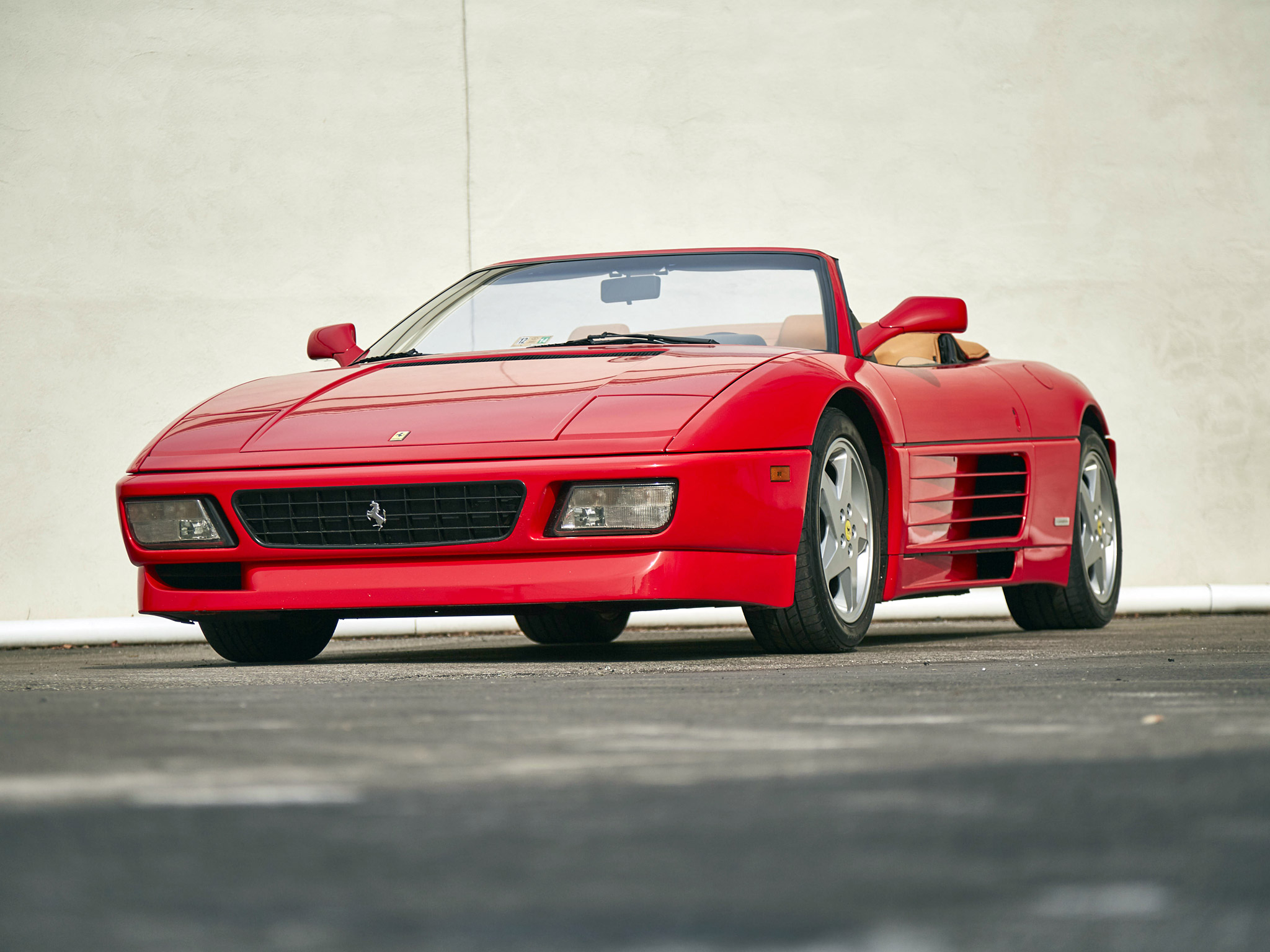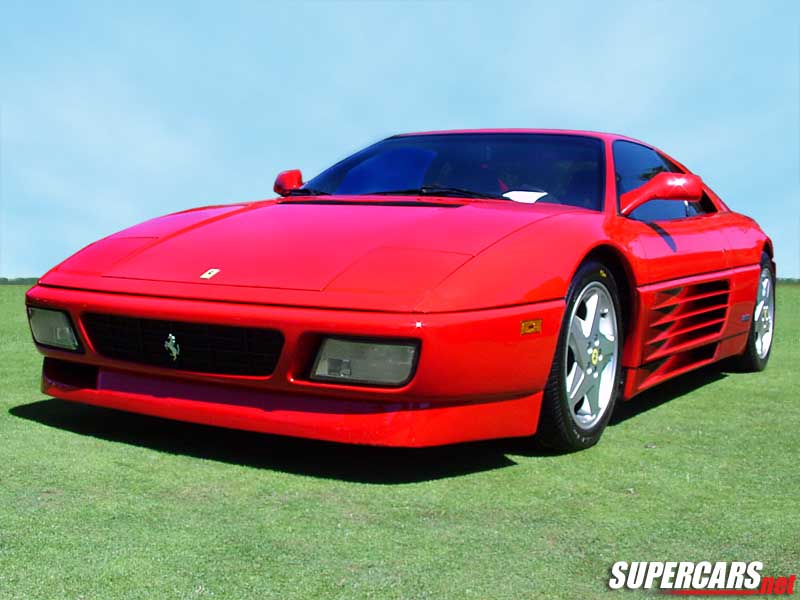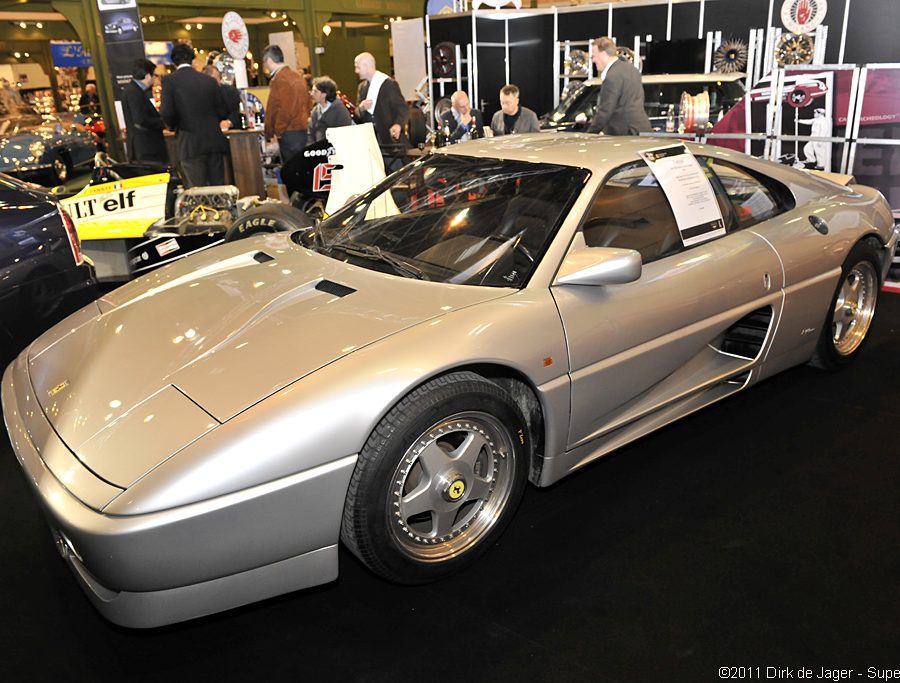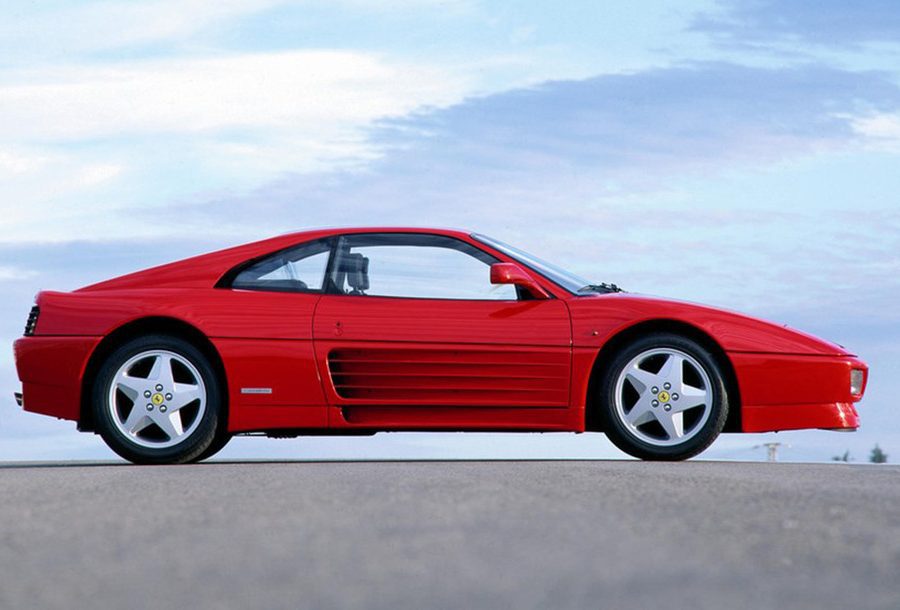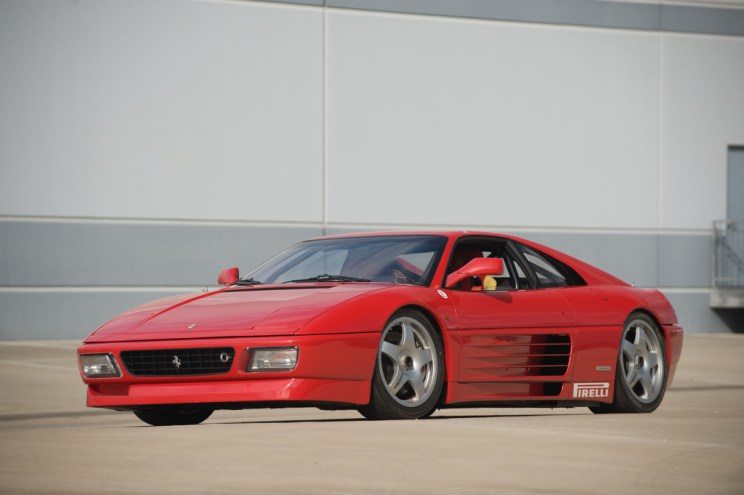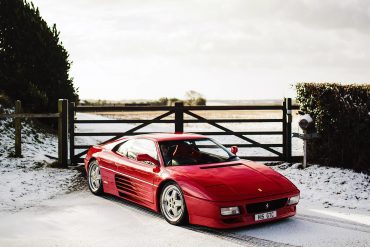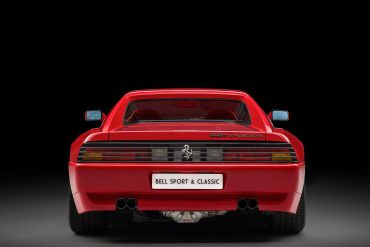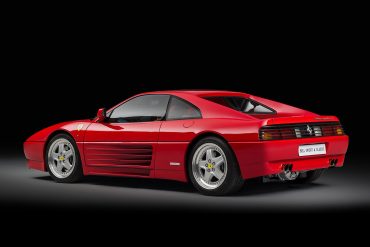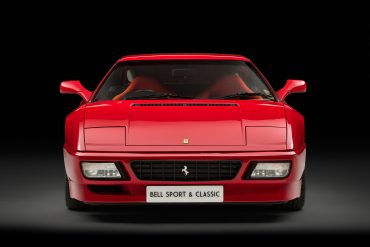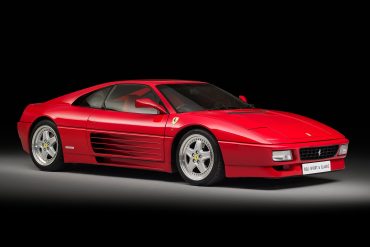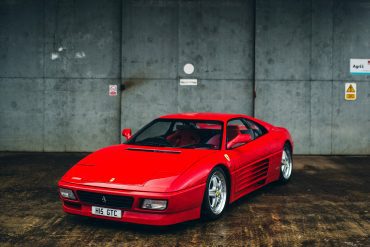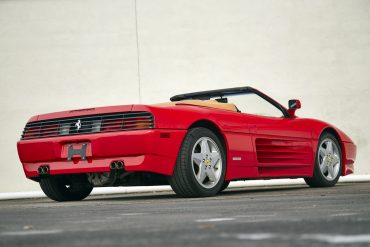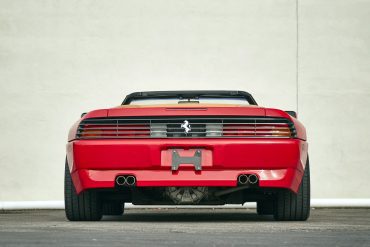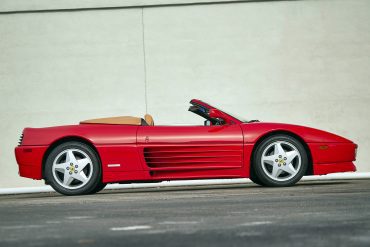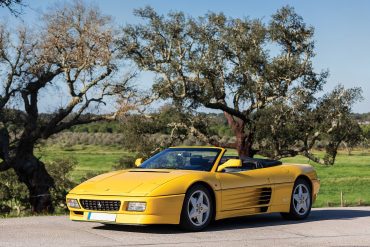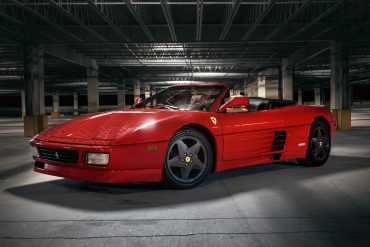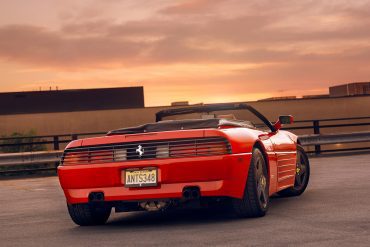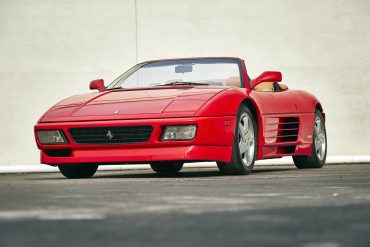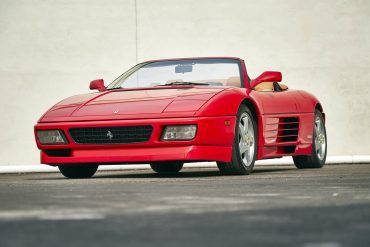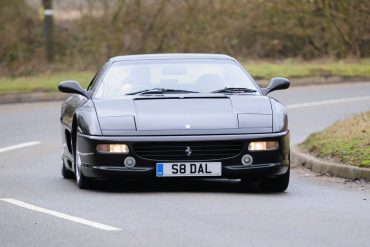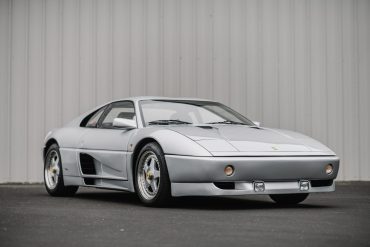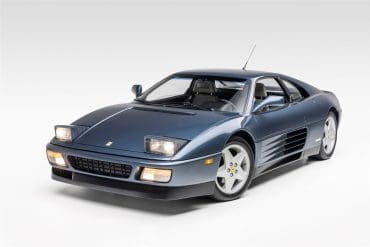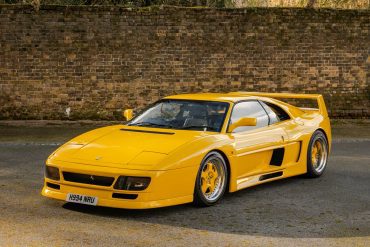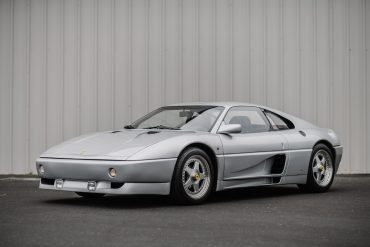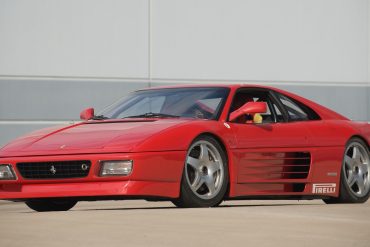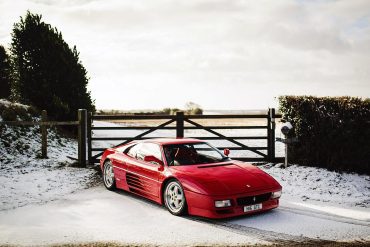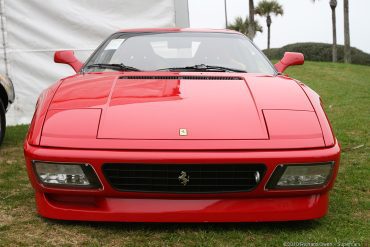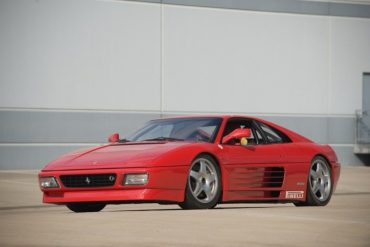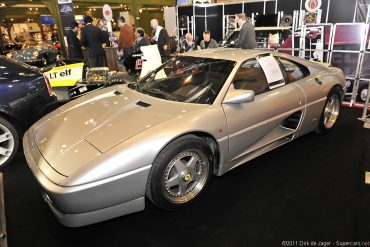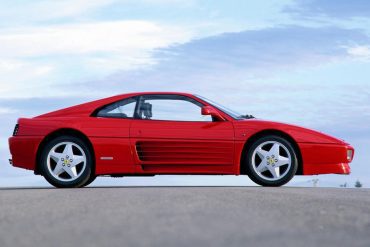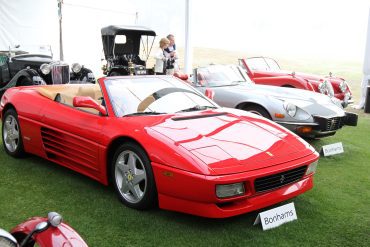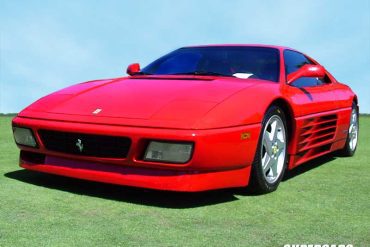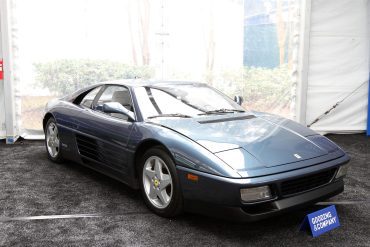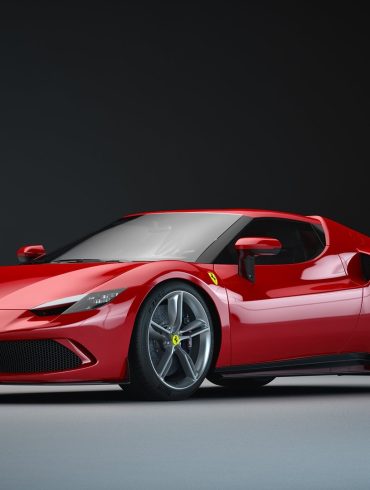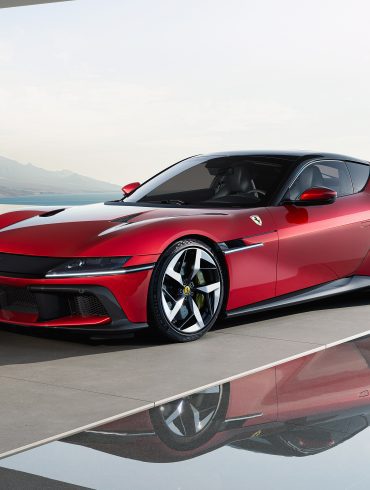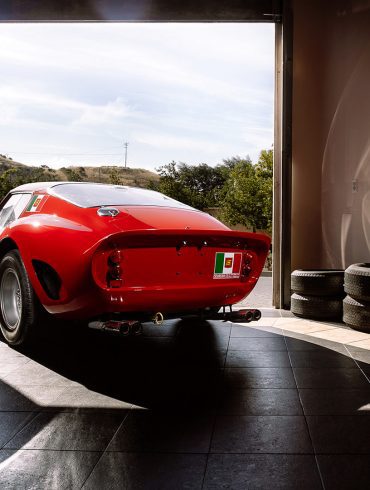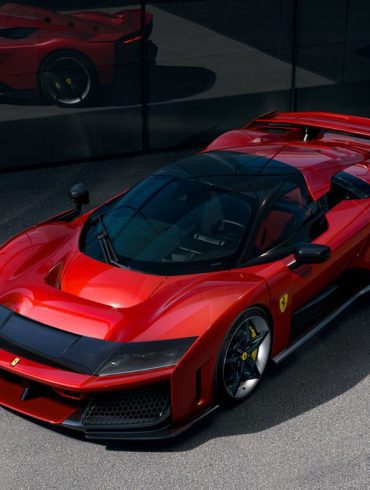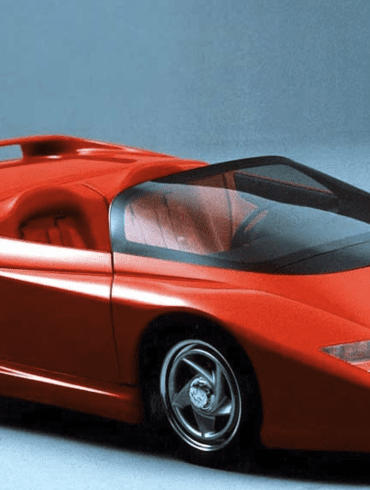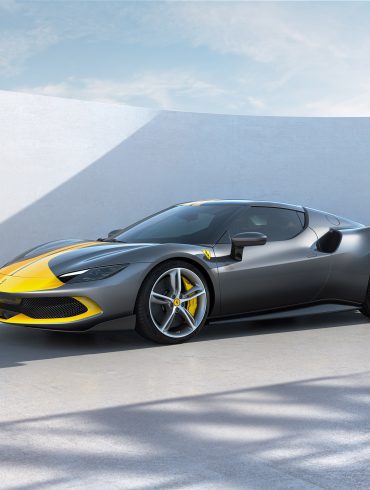Ferrari 348 tb & ts Introduced in 1989, the 348 was a major departure for Ferrari’s successful road-going, mid-engine series of sports cars and it replaced two of the most popular Ferrari models in history, the 308 and the 328. The new car featured a pressed-steel monocoque chassis that helped...
Ferrari 348
The Ultimate Guide
Introduced in 1989, the 348 was a major departure for Ferrari’s successful road-going, mid-engine series of sports cars and it replaced two of the most popular Ferrari models in history, the 308 and the 328. The 348, badged 348 tb for the coupé (Transversale Berlinetta) and 348 ts for the targa (Transversale Spider), featured a naturally aspirated 3.4-litre version of the quad-cam, four-valve-per-cylinder V8 engine. The 348 was fitted with dual-computer engine management using twin Bosch Motronic ECUs, double-redundant anti-lock brakes, and self-diagnosing air conditioning and heating systems. Late versions (1993 and beyond) have Japanese starter motors and Nippondenso power generators to improve reliability, as well as the battery located within the front left fender for better weight distribution.
Overview / Variants / Models In-Depth / Buyer's Guide / Images / More Updates
Ferrari 348 - Not For The Faint of Heart
The Ferrari 348, produced from 1989 to 1995, holds an interesting place in Ferrari’s history. Positioned as the successor to the 328 and a precursor to the F355, the 348 introduced new technologies and styling cues that pointed Ferrari toward the future.
However, it faced mixed reviews and became a controversial model due to its unique design and handling characteristics. In retrospect, the Ferrari 348 has become a beloved classic for many, cherished by enthusiasts who appreciate its analog driving experience and distinctive personality.
This article delves into the history, legacy, and performance of the Ferrari 348, including insights from contemporary reviews to better understand its impact and how it’s viewed today.
A Step Forward
The Ferrari 348 was developed to replace the successful 328, and it marked a significant shift in Ferrari’s design and engineering approach. Unveiled in 1989 at the Frankfurt Motor Show, the 348 introduced several new features that aimed to modernize Ferrari’s V8 lineup:
Monocoque Construction: The 348 was the first V8 Ferrari to feature a full monocoque chassis, offering greater rigidity and safety compared to its predecessors.
Longitudinally Mounted Engine: Ferrari opted to mount the 348’s 3.4-liter V8 engine longitudinally, a change from the transverse layout in the 328. This arrangement, inspired by Ferrari’s F1 cars, contributed to better weight distribution and cooling.
Styling by Pininfarina: The 348 incorporated styling cues from the Testarossa, particularly the distinctive side strakes and taillight design, giving it a more aggressive and modern appearance.
The 348 was available in multiple variants over its production run, including the 348 TB (coupe), 348 TS (targa), and the Spider, which was introduced in 1993 as Ferrari’s first fully open-top model since the Daytona Spider.
Testarossa Inspiration and ’90s Flair
Designed by Pininfarina, the Ferrari 348 embraced a bold look inspired by the larger Testarossa. The styling was unmistakably Ferrari but broke away from the softer lines of previous models, instead opting for sharp angles and an athletic stance. Key design elements included:
Side Strakes: The 348’s side strakes, a signature element of the Testarossa, stretched across the doors, giving the car an aggressive appearance that matched its performance ambitions.
Rear Grille: The rear grille covered the taillights, a unique design feature that emphasized Ferrari’s new approach to styling and aerodynamic efficiency.
Cabin and Interior: The 348’s cabin focused on minimalism, with a driver-oriented cockpit and analog controls. It was equipped with bolstered seats, classic Ferrari gauges, and a gated manual shifter, creating an intimate, analog driving experience.
The 348’s aesthetic has aged well over time, and it’s now recognized as a quintessentially 1990s design that encapsulates Ferrari’s styling philosophy during the era.
Raw and Demanding
The Ferrari 348’s 3.4-liter V8 engine, producing 300 horsepower and 238 lb-ft of torque, was a significant improvement over the 328. Equipped with dual overhead camshafts, a flat-plane crankshaft, and electronic fuel injection, the 348’s powertrain provided a lively, high-revving character that rewarded skilled drivers. Key performance metrics include:
0-60 mph: The 348 accelerated from 0 to 60 mph in around 5.6 seconds, placing it among the competitive sports cars of the time.
Top Speed: With a top speed of approximately 171 mph, the 348 offered thrilling performance for enthusiasts, providing a taste of Ferrari’s racing heritage.
While the power figures were impressive, the 348’s handling was somewhat divisive among reviewers, many of whom noted that the car required a skilled hand to extract its full potential. In a 1991 Car and Driver review, the 348 was described as "unforgiving if pushed to its limits" but praised for its “direct connection between driver and machine.” This analog, visceral quality was both a blessing and a curse for the 348; it offered drivers an engaging experience but required careful control, especially at high speeds.
Ferrari attempted to address some of these handling challenges with the 348 Serie Speciale, introduced in 1992. This limited-edition model featured revised suspension, wider rear tires, and a slight power increase, which improved stability and responsiveness.
Mixed Reviews
The Ferrari 348 received mixed reviews from the automotive press upon its release. While it was praised for its design and performance, some critics found fault with its handling characteristics. The car’s tendency to oversteer, particularly in challenging driving conditions, led some reviewers to caution potential buyers.
In a review by Road & Track, the 348 was described as "a thrilling machine but demanding of its driver." The reviewer praised the car’s raw performance and connection to the road but noted that the car’s handling could be tricky, especially at the limit. “The 348 is not for the faint-hearted,” the review stated, highlighting the car’s need for experienced drivers.
Autocar also remarked on the car’s character, stating, “The 348 is a Ferrari in the purest sense, for better or worse. It requires commitment, and it rewards it.” This sentiment captures the essence of the 348; it was a car that demanded respect, a model that could shine in the hands of skilled drivers but would challenge those unfamiliar with its nuances.
Ferrari’s own Formula 1 driver, Niki Lauda, was famously critical of the 348’s handling, leading Ferrari to address these concerns more comprehensively in the F355, the 348’s successor. While Lauda’s feedback influenced the brand’s approach, many enthusiasts embraced the 348’s unique character, considering it a driver-focused Ferrari that celebrated analog performance.
A Beloved Classic with a Unique Character
In the years since its production, the Ferrari 348 has grown in popularity and is now appreciated as a raw, analog Ferrari from an era before electronic aids took over. Its uncompromising nature has made it a favorite among purists who value direct, unfiltered driving experiences.
The 348’s styling has also aged well, with its Testarossa-inspired design making it instantly recognizable. For enthusiasts, the 348 represents a turning point for Ferrari, one that combines classic design elements with modern technology. The model’s monocoque construction and longitudinal engine layout laid the foundation for the F355 and influenced the evolution of Ferrari’s V8 lineup.
Today, the Ferrari 348 is seen as an underappreciated gem, a car that embodies the spirit of Ferrari’s analog era. Its quirks and demands are now viewed as part of its charm, and its rising collectibility reflects an increasing appreciation for its unique place in Ferrari’s history.
Analog Desirability
As modern Ferraris become more computerized, the analog qualities of the 348 have become increasingly appealing to collectors and enthusiasts. The 348’s place as a bridge between the classic Ferrari models of the 1980s and the more advanced models of the 1990s gives it a unique appeal.
Rising Values: The 348 has seen a steady increase in value over the past decade, with collectors beginning to recognize its significance. Well-maintained, low-mileage examples with complete service histories tend to command premium prices.
Limited-Edition Models: Special versions, such as the 348 Serie Speciale and Competizione, are especially desirable. These limited editions offer enhanced performance and rarity, making them appealing to collectors.
Future Investment Potential: As one of Ferrari’s last analog V8 models, the 348 is positioned for future appreciation. Its unique styling and driver-focused character ensure it remains a standout model, and its value is expected to continue rising as more enthusiasts seek out classic, analog Ferrari experiences.
The Ferrari 348’s Enduring Appeal
The Ferrari 348 may have had a polarizing reception upon release, but time has allowed enthusiasts to embrace its unique character. Its analog nature, distinctive design, and demanding driving dynamics make it a car that rewards skilled drivers and appeals to purists.
The 348 is no longer overshadowed by its successor, the F355; instead, it is appreciated as an important link in Ferrari’s evolution. Its rising values and growing status as a collectible classic reflect a newfound respect for its quirks and challenges. For those who value Ferrari’s tradition of driver-focused, analog performance, the Ferrari 348 remains a compelling choice—an emblem of the marque’s transition into the modern era, and a model that continues to capture the imagination of enthusiasts worldwide.
Ferrari 348 Specs
Manufacturer: Ferrari
Production: 1989–1995
Produced: 8,844 units
Assembly: Maranello, Italy
Designer: Leonardo Fioravanti
Class: Sports car (S)
Body style: 2-door Berlinetta (tb, GTB), 2-door targa top (ts, GTS), 2-door convertible (Spider)
Layout: Longitudinal, rear mid-engine, RWD
Engine: 3.4 L Tipo F119 V8
Transmission: 5-speed manual
Wheelbase: 2,450 mm (96.5 in)
Length: 4,230 mm (167 in)
Width: 1,894 mm (74.6 in)
Height: 1,170 mm (46.1 in)
Kerb weight: 1,500 kg (3,300 lb)
Predecessor: Ferrari 328
Successor: Ferrari F355
Did You Know?
The 348 holds a special place in Ferrari history as the final V8 model to be greenlit by Enzo Ferrari himself before his passing in 1988. It carries a piece of his legacy.
Unlike the 328, which had a transversely mounted engine, the 348 featured a longitudinally mounted V8, similar to the Testarossa. This change significantly impacted the car's handling and weight distribution.
A limited-production "Serie Speciale" version was introduced with enhanced performance, featuring increased horsepower, a revised suspension, and unique styling elements.
The 348 Challenge race car was a popular choice in various motorsport series, showcasing the platform's competitive potential.
Ferrari 348 Variants
There were several variants of the 348 over the years. We outline the key data on each below.
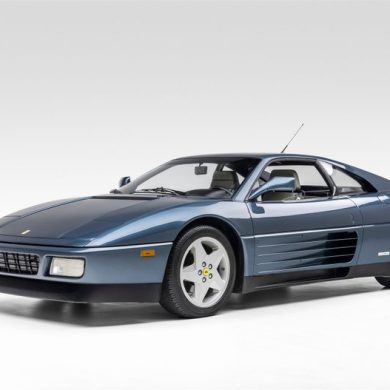
Ferrari 348 TB
Type: Production Car
Years: 1989 - 1993
Production: 2,895 units
Engine: 3.4 L Nat Asp V8
Power: 296 bhp @ 7200 rpm
Torque: 238 lb/ft @ 4200 rpm
0-60 mph: 6.0 seconds
Top Speed: 166 mph
Auto journalists described the 348 as, "something quite special," and the engine being the formative element in defining the car's character, rising in an, "operatic crescendo," having the, "power to raise goose bumps". Some areas of critique focused around the long-established topic of Ferrari gearboxes, typically stiff and balky when cold. The 348 did not break from tradition in this area. Learn More.
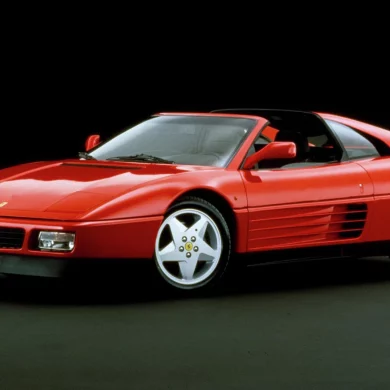
Ferrari 348 TS
Type: Production Car
Years: 1989 - 1993
Production: 4,230 units
Engine: 3.4 L Nat Asp V8
Power: 296 bhp @ 7200 rpm
Torque: 238 lb/ft @ 4200 rpm
0-60 mph: 46.0 seconds
Top Speed: 166 mph
Auto journalists described the 348 as, "something quite special," and the engine being the formative element in defining the car's character, rising in an, "operatic crescendo," having the, "power to raise goose bumps". Some areas of critique focused around the long-established topic of Ferrari gearboxes, typically stiff and balky when cold. The 348 ts stood for the targa (Transversale Spider) body. Learn more.
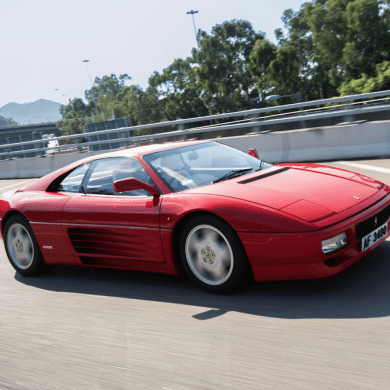
Ferrari 348 GTB
Type: Production Car
Years: 1993 - 1995
Production: 252 units
Engine: 3.4 L Nat Asp V8
Power: 316 bhp @ 7200 rpm
Torque: 238 lb/ft @ 4200 rpm
0-60 mph: 5.4 seconds
Top Speed: 174 mph
Modified from the 348 TB, the 348 GTB was a two-seater berlinetta with dynamic performance characteristics worthy of the marque's highest traditions. Its sports orientation was best expressed on the track, as proven by the 348 Challenge, which saw this car race on circuits in Europe and the US. It had the updated Japanese starter motors and Nippondenso power generators to improve reliability. Learn more.
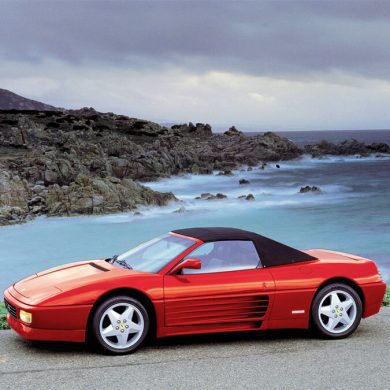
Ferrari 348 GTS
Type: Production Car
Years: 1993 - 1995
Production: 137 units
Engine: 3.4 L Nat Asp V8
Power: 316 bhp @ 7200 rpm
Torque: 238 lb/ft @ 4200 rpm
0-60 mph: 5.4 seconds
Top Speed: 174 mph
This two-seater convertible offered the same specifications as the 348 GTB, with the choice of open or closed-top motoring and a layout that had by now become a Ferrari classic: as on the outgoing TS, the hard top was stowed away in the space behind the seats. The revised cars were presented to the public as the 348 GT versions, equipped with the F119H engine. Learn more.
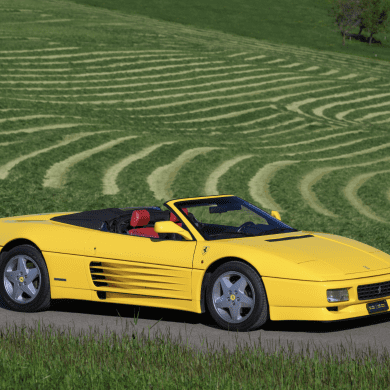
Ferrari 348 Spider
Type: Production Car
Years: 1993 - 1995
Production: 1,090 units
Engine: 3.4 L Nat Asp V8
Power: 316 bhp @ 7200 rpm
Torque: 238 lb/ft @ 4200 rpm
0-60 mph: 5.4 seconds
Top Speed: 174 mph
In 1993, Ferrari tweaked the 348 lineup, adding the power and handling upgrades from the Serie Speciale to the TS and TB, renaming both to the GTS (targa) and GTB (coupe). For the first time in the history of Ferrari mid-engine V-8 two-seaters, the 348 incorporated a full drop-top variant called the 348 Spider, replacing the mid-engine Mondial cab. Learn more.
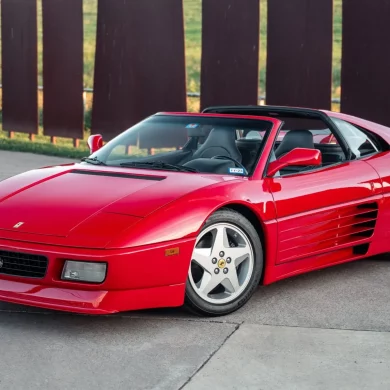
Ferrari 348 Serie Speciale
Type: Special Edition
Years: 1992 - 1993
Production: 100 units
Engine: 3.4 L Nat Asp V8
Power: 312 bhp @ 7,200 rpm
Torque: 238 lb/ft @ 4200 rpm
0-60 mph: 5.3 seconds
Top Speed: 171 mph
Between 1992 and 1993 Ferrari made 100 limited edition units of 348 Serie Speciale specifically for the US market. The main technical modifications consisted in a revised engine, a free flow exhaust system, a shorter ratio final drive and Pirelli P Zero tyres. Ferrari indicated a 0-60 mph time of 5.3 seconds and a standing ¼ mile of 13.75 seconds. The U.S only car is truly rare even by Ferrari standards.
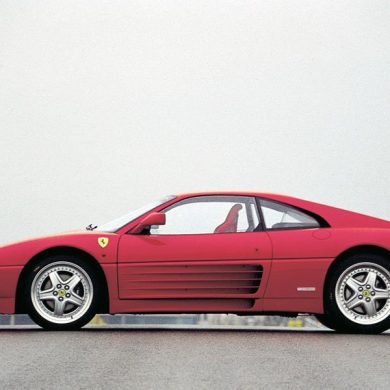
Ferrari 348 GT Competizione
Type: Special Edition
Years: 1993 - 1994
Production: 50 units
Engine: 3.4 L Nat Asp V8
Power: 320 bhp @ 7,200 rpm
Torque: 238 lb/ft @ 4200 rpm
0-60 mph: 5.6 seconds
Top Speed: 171 mph
To celebrate Larrauri’s Italian GT2 title and mark the end of 348 production, Ferrari decided to offer a limited run of 50 high performance specials based on the existing GTB platform. Announced in December 1993, the 348 GT Competizione was the last and ultimate road-going iteration of the 348. Deliveries began in spring 1994, but the new model was not legal for sale in North America on emissions grounds. Learn more.
"The 348's engine is a gem. It's responsive, eager to rev, and it produces a glorious soundtrack."
Road & Track (at the time of launch)
Ferrari 348 Buyer's Guide
Buying Tips & Things to Look for When Buying A Used Ferrari 348
Here’s a buyer’s guide for the Ferrari 348, covering essential considerations, potential maintenance issues, and insights on its desirability and investment potential.
1. Engine and Timing Belt Health
The Ferrari 348’s 3.4-liter V8 engine delivers exhilarating performance, but it requires regular maintenance:
Timing Belt: The 348’s timing belt should be replaced every 3-5 years. This is an engine-out service, so it’s costly. Ensure the car has a recent timing belt service documented, as a failure can cause severe engine damage.
Engine Health: Look for smooth revving and consistent power delivery during a test drive. Any unusual sounds from the engine, such as knocking or misfires, should be examined by a Ferrari specialist.
Oil Leaks: Oil leaks around the engine and cam seals are not uncommon, especially on high-mileage examples. Inspect for oil seepage, particularly around the valve covers and timing belt area.
2. Transmission and Clutch Condition
The 348 comes with a gated 5-speed manual transmission, prized for its mechanical feel but sensitive to wear:
Clutch Wear: The 348’s clutch may need replacement depending on mileage and driving style. Look for signs of slipping or difficulty engaging gears. Ask for service records showing when the clutch was last replaced.
Synchros: Gear synchro wear is a common issue, especially in second gear. Shifts should be smooth, and any grinding or resistance during gear changes may indicate wear on the synchros.
Gearbox Oil: Check the service history to confirm regular gearbox oil changes. Fresh oil helps maintain smooth shifts and minimizes wear on transmission components.
3. Electrical System and Interior Components
Electrical gremlins are a known issue on the 348, especially as the car ages:
Slow Power Windows: Power windows can operate slowly, often due to failing window motors. While not a severe issue, it can be costly to repair.
Fuse Box and Wiring: Electrical issues can stem from aging wiring or fuse box malfunctions. Ensure that all lights, switches, and controls function correctly, as electrical repairs on the 348 can be labor-intensive.
Sticky Interior Components: The 348’s interior plastics can become “sticky” over time, especially if exposed to heat. This cosmetic issue can be resolved by refinishing or replacing affected components.
4. Suspension and Handling Components
The Ferrari 348’s suspension system provides excellent handling but requires maintenance:
Bushings and Ball Joints: Inspect the suspension bushings and ball joints for wear or cracking, as these components can degrade with age. Replacing worn bushings will restore handling precision.
Shock Absorbers: The shocks on the 348 are prone to leaking over time, affecting ride quality and handling. Look for any signs of oil leaks around the shock absorbers.
Wheel Bearings: Check for any play in the wheels, as worn wheel bearings can lead to alignment and handling issues.
5. Cooling System and Radiators
The 348’s cooling system is crucial to maintaining engine temperature, especially during spirited driving:
Radiators: Inspect the radiators for any signs of damage or corrosion, especially around the front where they’re vulnerable to debris.
Coolant Leaks: Any coolant leaks could indicate a compromised cooling system. Verify that the car has had regular coolant flushes to prevent overheating and corrosion in the system.
Cooling Fans: The 348’s fans should engage when the engine temperature rises. Confirm that the fans are working correctly, as malfunctioning fans can lead to overheating.
6. Body and Frame Condition
The Ferrari 348’s body and frame are susceptible to wear, especially on cars that have been driven regularly:
Rust in Vulnerable Areas: While rust is not widespread in the 348, it can appear around the door sills, wheel arches, and underbody if the car hasn’t been stored properly. Inspect these areas for any signs of rust or bubbling paint.
Underbody Damage: Given the car’s low ride height, check for scrapes or dents on the underbody, especially near the front lip and side skirts.
Convertible Top (Spider Models): If you’re looking at a 348 Spider, check that the convertible top operates smoothly and that the fabric is in good condition. Repairing the convertible mechanism can be expensive.
7. Exhaust System and Emissions
The 348’s exhaust system requires attention, particularly in older models:
Exhaust Manifolds: The 348’s exhaust manifolds can develop cracks over time, especially if the car has been driven aggressively. Replacement is costly, so look for signs of exhaust leaks or ask for recent replacement records.
Catalytic Converters: Catalytic converters on the 348 can degrade with age, causing rattling sounds or reduced power. Replacement is necessary to ensure optimal performance and compliance with emissions standards.
Exhaust Bypass Valve: The 348’s exhaust bypass valve, which opens at higher RPMs, should operate smoothly. A faulty bypass valve can affect sound and performance.
8. Desirability and Future Investment Potential
The Ferrari 348 is enjoying a resurgence among collectors and enthusiasts who appreciate its raw, analog driving experience and classic Ferrari styling.
Rising Values: The 348’s value has been steadily increasing as collectors recognize its unique character and status as one of the last analog Ferraris. Prices are expected to continue rising, particularly for well-maintained, low-mileage examples.
Classic Ferrari Styling: The 348’s styling, with its Testarossa-inspired side strakes and distinctive rear grille, makes it a recognizable Ferrari from the 1990s, appealing to those who appreciate Ferrari’s design legacy.
Investment Potential: As one of the final Ferraris produced before the era of electronic driving aids, the 348 is viewed as a modern classic. Special versions, like the 348 Serie Speciale and Competizione, hold particular appeal due to their rarity and enhanced performance, making them prime candidates for appreciation.
Driving Experience Appeal: The 348’s analog nature and driver-focused characteristics are increasingly sought after, especially as modern supercars become more computerized. For purists, the 348 offers a raw, engaging experience that’s becoming rare in today’s market.
9. Cost of Ownership and Maintenance
Maintaining a Ferrari 348 is a commitment, and prospective buyers should be prepared for ongoing expenses:
Routine Service: Regular servicing by Ferrari-certified specialists is essential. The timing belt change, which requires an engine-out service, is among the most significant maintenance expenses.
Storage and Preservation: Proper storage in a climate-controlled environment is recommended to protect the 348’s electrical components, cooling system, and bodywork from damage.
Insurance and Running Costs: Insurance premiums for the 348 can be significant due to its collectible status and Ferrari’s reputation. Routine running costs, including fuel and regular maintenance, should also be factored into ownership.
Conclusion
The Ferrari 348 may have had a mixed reception upon its release, but it’s increasingly recognized as a classic Ferrari that delivers an analog driving experience. When buying a 348, prioritize models with comprehensive service records, recent maintenance, and original components. With its distinctive style, engaging driving dynamics, and growing status as a modern classic, the Ferrari 348 is an appealing investment for collectors and enthusiasts alike, and its values are expected to appreciate as it gains recognition in the Ferrari community.
"The 348's handling can be tricky at the limit. It requires a delicate touch and a skilled driver to extract its full potential."
Motor Trend (at the time of launch)


